I’m preparing a slide show for an upcoming talk on the Birds of India, and one of the most charming ones is Athene brama, the Spotted Owlet:
Tiny little birds (hence the diminutive “owlet”), they are nonetheless mobbed mercilessly if they don’t choose their daytime hiding place carefully. At the Okhla Bird Sanctuary where I snapped the above image, they roost in a giant banyan tree at the western end of a large weir, close by a house. They’re almost always there, but the trouble with finding Spotted Owlets isn’t knowing where they hang out: it’s spotting them! They are very good at hiding:
But once spotted, Spotted Owlet is sometimes fairly confiding. A good photographer would have had no trouble getting sharper images than these.
There are 4 species in the genus Athene: Spotted Owlet, A. brama, found throughout India and Pakistan; Forest Owlet, A. blewitti, a much more range-restricted Indian species; Little Owl, A. noctua, widespread throughout Eurasia and into North Africa; and one New World species, Burrowing Owl, A. cunicularia. This last species has an extremely wide distribution across both American continents, with 20 subspecies recognized by some authorities.
The Burrowing Owl should have a special place in the heart of any naturalist from Boca Raton: Athene cunicularia floridana is the mascot of the local public university, Florida Atlantic University. They live on the campus, which is located on the site of a former Army Air Corps training center (part of which lives on as an airport, Boca Raton Airport). I see them almost every time I ride my bike along the El Rio Canal, which runs along the eastern edge of the campus. They like to hang out on the berms of their burrows, or on the little T-shaped perches that the campus environmental scientists put up for them. They are perch hunters, so they appreciate the boost those little Ts give them.
I’ve lived in Boca for ten years now, and I see these little guys almost weekly, but when I searched my photo files for pictures of burrowing owls, I came up completely empty. So I set out early this morning with my digiscoping rig to rectify the situation. The owls occupy precious real estate on the campus, but for now at least, many of the most accessible sites appear to be unthreatened by development, although the new football stadium on campus is going smack on top of one of their larger sites. Just as important as their living quarters, though, and much less protected by any state regulation, are their foraging grounds. We can only hope that the university will keep enough open space for these guys to hunt the bugs and small lizards and rodents that comprise their diet, otherwise there will be no burrowing owls on campus except the wingless, featherless kind!
Here are a few of the better shots from this morning’s session:
The yellowish cast of the photos is an effect of the light; the sun had just risen when these shots were taken. Like many birds, these owls tend to be most visible at dawn and dusk.
The Burrowing Owl is the only member of its genus that lives underground. The other three species all live in trees, as “proper” owls do. The specific epithet, cunicularia, means miner in Latin, borrowed from the Greek kúniklos, which has to do with another burrowing animal, the rabbit. (Coney-cunicularia. There’s a whole branch of animal husbandry called cunicularium, which has to do with raising rabbits.) And in many parts of their range, these owls do take over abandoned rabbit holes, or prairie dog holes, or whatever is handy. (The decline of the prairie dog in the Midwest has been blamed for the decline of the Burrowing Owl there as well.) Here in the loose, sandy soils of Florida, they tend to dig their own holes, although they’re not too proud to take over an old gopher tortoise hole if one is available.

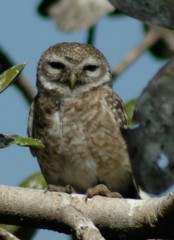
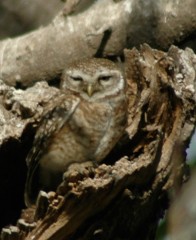
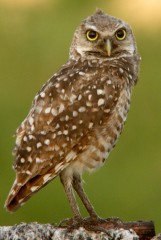
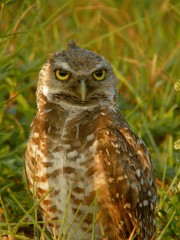
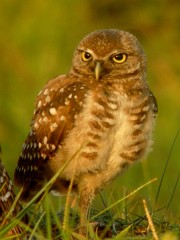
I’m reminded of one of my favorite words: crepuscular
A decade ago I saw a tiny owl in Colorado’s high country. It disappeared too quickly for me to photograph. Apparently we’ve got a few species of migratory owls there.
Great link, Oroboros! Thanks!
These owls aren’t exactly crepuscular; they’re active much of the day (although they do take their siestas during the heat) and most, if not all, of the night as well. They’re just most observable in the crepuscular hours.
In fact, the Very First Time I saw one was around 10 p.m. as I was driving around on campus. It swooped in front of my slow-moving car and perched on a nearby stop sign. I was so excited I started whooping!
Heh. By “these owls” I mean the Burrowing Owls. Don’t know enough about the habits of the Spotted Owlet, although the research I’ve done indicates that they’re much more nocturnal than the BUOW.